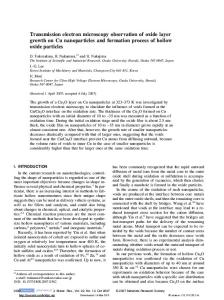Transmission electron microscopy observation of the microemulsion process and the magnetic properties of the resultant n
- PDF / 1,835,600 Bytes
- 5 Pages / 612 x 792 pts (letter) Page_size
- 89 Downloads / 344 Views
nocrystalline Ni–Zn ferrite particles (Ni0.5Zn0.5Fe2O4) have been successfully produced by microemulsion method. The microemulsion process was first observed by transmission electron microscopy examination. The particles exhibit a blocking temperature of 95 K. They do not attain saturation magnetization even at a high field of 50 KOe. The saturation magnetization at 300 K is 29.8 emu/g, which is significantly lower than that reported for the bulk ceramic standard. Below the blocking temperature, the Ni0.5Zn0.5Fe2O4 nanocrystalline particles exhibit a hysteretic feature. The remanent magnetization and coercivity at 2K are 10.45 emu/g and 453 Oe, respectively.
I. INTRODUCTION
II. EXPERIMENTAL
During last few decades, the spinel ferrites have been extensively investigated because of their remarkable magnetic properties particularly in radio-frequency region, physical flexibility, high electrical resistivity, mechanical hardness, and chemical stability. Magnetic properties of the ferrites strongly depend on the microstructure, particle size, and surface-to-volume ratio. Various properties such as superparamagnetism and spin canting are observed when the particle is reduced to nanometric size. Synthesis of ferrite nanoparticles is of great importance for the investigation and exploitation of their specific properties.1 There are a variety of methods to prepare ultrafine particles including mechanical milling,2 coprecipitation,3 hydrothermal synthesis,4 sol-gel synthesis,5 etc. Among these processes, preparation in a microemulsion has lately shown to be a promising technique for the preparation of nanocrystalline ferrite particles with controlled size and morphology.6 In this article, transmission electron microscopy (TEM) observation of the microemulsion process during the preparation of nanocrystalline Ni–Zn ferrites was first presented, which directly and vividly revealed each step of the process. It may help to validate and understand the principle of microemulsion technology in the preparation of nanoparticles. Also the magnetic properties of the resultant nanoparticles were characterized.
Ni0.5Zn0.5Fe2O4 nanoparticles were prepared using microemulsion procedures. A microemulsion system with cetyltrimethyl ammonium bromide (CTAB) as the surfactant, n-butanol as the consurfactant, n-octane as the oil phase and an aqueous solution as the water phase was chosen. Microemulsions were prepared by solubilizing different salt solutions into CTAB/n-butanol/n-octane solutions. Two microemulsions (I and II) with identical compositions but different aqueous phases were taken. The aqueous phase in microemulsion I was a solution of 0.05 mol/l nickel nitrate, 0.05 mol/l zinc nitrate, and 0.2 mol/l iron nitrate. The aqueous phase in microemulsion II was a solution of ammonium hydroxide, the precipitating agent, taken in a concentration 10% greater than that required stoichiometrically for complete precipitation of the hydroxide. Table I shows the compositions of the microemulsions I and II used for synthesis reaction. The two mic
Data Loading...











